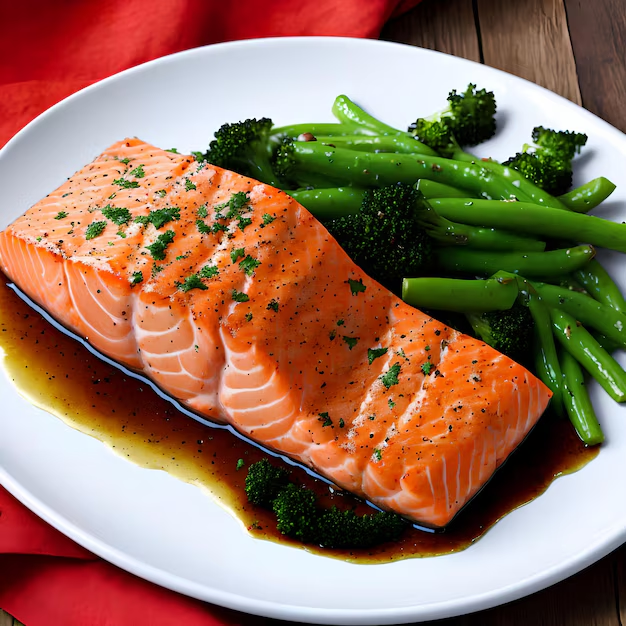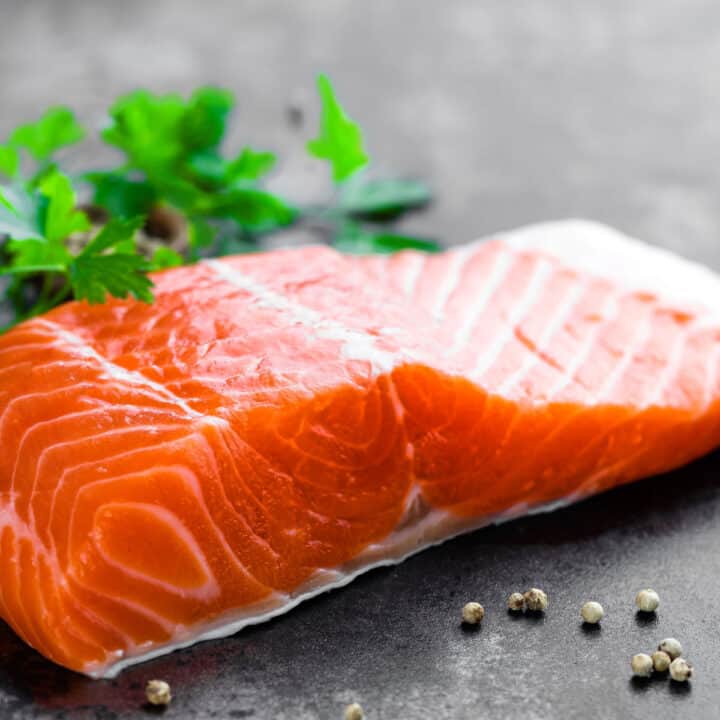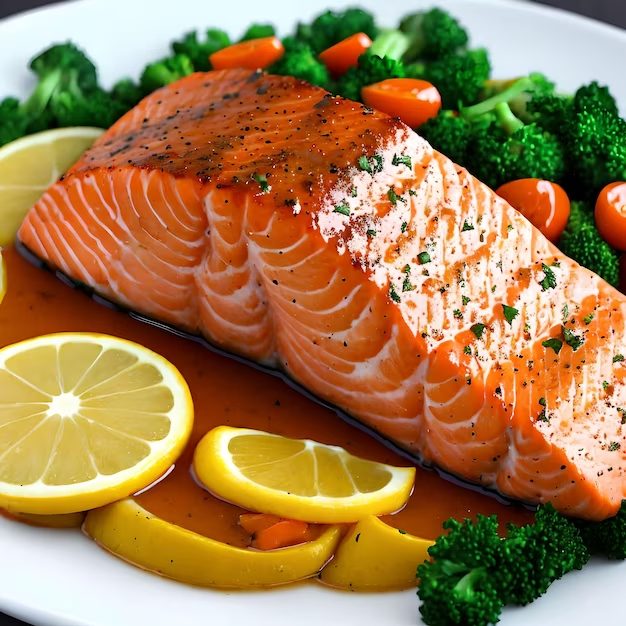Determining the Shelf Life of Cooked Salmon
Cooking salmon provides a tasty and healthy meal. But, it’s important to know how long leftovers last. Shelf life is the time cooked salmon stays fresh enough to eat. According to the USDA, you can keep cooked salmon in the fridge for 3 to 4 days. Remember, quality and safety are key. To keep salmon safe, store it right after it cools down. Don’t leave it out at room temperature for more than 2 hours. Also, be aware of signs that salmon has gone bad before eating. These include a strong fishy smell, slimy texture, or dull color. If you spot these signs, it’s best to throw the salmon out. When reheating, make sure it reaches 145 degrees Fahrenheit. This kills any bacteria that might have grown. Follow these guidelines to enjoy your cooked salmon safely and deliciously.

Proper Preparation and Cooling Techniques for Storage
To ensure cooked salmon stays fresh, it’s crucial to cool it properly before refrigeration. Follow these steps for optimal food safety:
- Let the Salmon Cool: After cooking, let the salmon sit at room temperature for a short period. Do it quickly; exceeding 2 hours increases the risk of bacterial growth.
- Shallow Containers for Rapid Cooling: Transfer the salmon to shallow containers. This allows quick, even cooling and prevents the inside from staying warm.
- Cover to Protect: Cover the cooked salmon with a lid or wrap it in cling film. This keeps out bacteria and other contaminants.
- Refrigerate Promptly: Once cool, place the salmon in the fridge immediately. Quick refrigeration is key to prolonging its freshness.
By cooling your cooked salmon rapidly and storing it properly, you can enjoy its flavors longer while keeping it safe for consumption. Remember, how long cooked salmon lasts in the refrigerator primarily depends on these initial steps.
Refrigerator Storage Guidelines
Storing cooked salmon in the fridge needs care. To make it last, follow these steps:
- Use Airtight Containers: Place the salmon in containers that seal well. This keeps out air and bacteria.
- Keep It Cold: Set your fridge to 40 degrees Fahrenheit or below. This slows down bacteria growth.
- Separate It: Store salmon away from raw food. This avoids cross-contamination.
- Consume Quickly: Eat within 3 to 4 days. Quality and safety are best when fresh.
Remember, storing salmon properly is key to enjoying it safely. Stick to these guidelines to make the most of your leftovers.
Freezing Cooked Salmon for Long-Term Preservation
To extend your cooked salmon’s shelf life, freezing is your best option. It helps keep the salmon safe to eat for a longer time. Here’s a simple guide to freeze your salmon correctly:
- Cool the Salmon: Let the cooked salmon reach room temperature before freezing. Never freeze it while it’s still hot.
- Wrap It Up: Use cling film or aluminum foil to wrap the salmon tightly. This step helps prevent freezer burn and taste loss.
- Airtight Packaging: Place the wrapped salmon in a freezer bag or container. Squeeze out excess air to keep it fresh.
- Label It: Write the date on the packaging. This way you know how long it’s been in the freezer.
- Freeze It: Put your wrapped and labeled salmon in the freezer immediately. The best freezing temperature is at 0 degrees Fahrenheit or lower.
- Thawing: When ready to eat, thaw the salmon in the fridge overnight. This method is safe and keeps the salmon’s quality.
Remember, frozen cooked salmon keeps well for up to six months. After that, it might still be safe to eat, but its quality could decline. Always check the salmon for signs of spoilage before cooking or reheating. Freeze your cooked salmon within 3 to 4 days of cooking to ensure it stays fresh.
 Signs That Indicate Spoilage in Cooked Salmon
Signs That Indicate Spoilage in Cooked Salmon
Recognizing when cooked salmon has spoiled is crucial for your health. Here are signs to look for:
Visual Changes
Be alert for these visual signs:
- Discoloration, like fading or grey areas, may signal spoilage.
- A slimy coat or a milky film on the salmon’s surface isn’t a good sign.
These changes often point to salmon that’s no longer safe to eat.
Unpleasant Odors
Trust your nose with these tips:
- Fresh cooked salmon should have a mild smell.
- A strong, sour, or fishy odor means the salmon may have gone bad.
If it smells off, it’s best to discard it.
Textural Differences
Feel for these texture clues:
- The surface shouldn’t be slippery; a slimy texture suggests spoilage.
- Salmon should be firm and flaky, not mushy.
If you’re unsure about its safety, it’s always safer to throw it out.
By looking for these signs, you can avoid consuming spoiled salmon. Eat your cooked salmon within the recommended 3 to 4 days and check for spoilage before eating leftovers. Always prioritize your health by being aware of these indications of bad salmon.
Tips on Safely Reheating and Consuming Leftover Salmon
To eat leftover salmon safely, follow these reheating steps:
- Preheat your oven: For a moist result, heat at 275 degrees Fahrenheit.
- Add moisture: Place salmon on a dish, add a bit of water or broth.
- Cover with foil: This keeps the salmon from drying out while it reheats.
- Warm it through: Heat until the salmon reaches an internal temperature of 125-130°F.
- Microwave Option: If short on time, use a microwave with care to avoid dryness.
- Add a splash of water: This helps maintain moisture in the salmon.
- Cover the dish: Use a lid or a moist paper towel when microwaving.
- Reheat in increments: Heat in 30-second bursts on low power, check regularly.
When eating salmon cold:
- Ensure it’s fresh: Smell and look at the salmon before eating it without reheating.
- Use your senses: If the salmon seems off, it’s safer to not eat it.
Always handle salmon safely to prevent illness, and remember to consume reheated salmon in one go. Repeated cooling and reheating can raise the risk of bacteria. Enjoy your salmon leftovers but always prioritize your health.
Creative Ways to Repurpose Cooked Salmon Before It Expires
Transform your cooked salmon leftovers into new flavor-packed dishes to enjoy before they expire. Here are some quick and delicious ideas:
- Salmon Salad: Flake the salmon and toss with greens, veggies, and your favorite dressing.
- Salmon Pasta: Mix salmon pieces into pasta with a light cream or tomato sauce.
- Salmon Rice Bowl: Combine salmon with rice, vegetables, and a drizzle of teriyaki or soy sauce.
- Salmon Omelette: Add salmon to eggs with herbs and cheese for a hearty breakfast.
- Salmon Cakes: Combine flaked salmon, breadcrumbs, and seasoning, then fry or bake.
- Salmon Spread: Blend salmon with cream cheese, lemon juice, and herbs for a tasty dip.
- Salmon Tacos: Stuff tortillas with salmon, slaw, and a squeeze of lime for a quick meal.
These are just a few ways to reinvent your cooked salmon. Get creative and make your favorite recipes. Use up cooked salmon within 3 to 4 days, and always check for freshness before using. Keep meals tasty and safe by repurposing your cooked salmon leftovers smartly.
 Frequently Asked Questions About Cooked Salmon Storage
Frequently Asked Questions About Cooked Salmon Storage
When it comes to storing cooked salmon, several questions often arise. Below are some frequently asked questions and their answers to help you store your salmon safely and make the most of your leftovers.
How long can you keep cooked salmon in the fridge?
Cooked salmon should be stored in the refrigerator and consumed within 3 to 4 days. Ensure it’s in an airtight container and kept at 40 degrees Fahrenheit or below.
What is the best way to store cooked salmon in the refrigerator?
Wrap the salmon tightly in plastic wrap or foil, then place it in an airtight container. Store it in the coldest part of the fridge to keep freshness.
Can you eat cooked salmon after 5 days?
It’s not recommended. The USDA suggests eating cooked salmon within 3 to 4 days for safety and quality.
How do you know if cooked salmon is bad?
Pay attention to the smell, texture, and color of the salmon. A sour smell, slimy texture, or color changes can all be signs of spoilage.
Can you freeze cooked salmon?
Yes, cooked salmon can be frozen. Wrap it well and use within six months for best quality. Always thaw in the refrigerator before reheating.
By keeping these tips in mind, you can safely savor your cooked salmon leftovers and reduce food waste. Always prioritize food safety to enjoy delicious and healthy meals.
